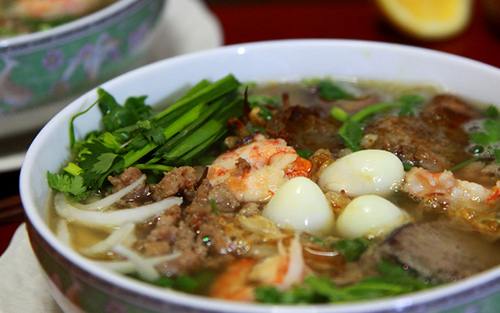Vietnamese Rice Noodles: A Century-Old Culture

Hu tieu My Tho or My Tho rice noodles is a delicacy of My Tho Town in the Mekong Delta Province of Tien Giang that has been a popular meal in South Vietnam for more than a century and listed as one of the Top 100 Dishes of Asia.
Rice noodles is a famous Asian dish which is served, together or separately, with broth and topped with shrimp, pork (minced and sliced), pig innards (liver, heart, etc.) and quail eggs. It is garnished with chives, bean sprouts and deep-fried shallots. Hu tieu My Tho may be mistaken for Hu tieu nam vang at first, an equally famous Phnom Penh rice noodle soup, but the former sets apart from its counterpart in its noodles and broth. Most rice noodles recipes are mixed with wheat flour or tapioca flour, but the My Tho version is made from pure rice flour. While most rice noodles are salty or sour, what's used in Hu tieu My Tho are transparent, chewy and sweet-smelling like rice. The right broth for the particular dish should blend with the noodles and not crumble or have a sour or salty taste, and My Tho's version achieves this perfectly.
Chin Xe Factory is the best rice noodles maker in My Tho who has been in the business for the last 70 years. Originally owned by the Phuc family, it is now run by the younger generation. It stands out from all the others in that it utilizes manual technique in almost the entire rice noodle-making process. Except in grinding the rice into flour and cutting the rice papers into noodles, the family members perform the whole procedure by hand and only by themselves to retain the quality and protect the sanctity of the original recipe. The Phuc family was able to preserve the traditional requirements of a good Hu tieu which are the following: high content of starch; right noodle chewiness which is achieved by setting the oven temperature to 120 Degrees Celsius and steaming the flour until it becomes chewy and transparent; wrapping the cooked rice papers around bamboo tubes; spreading the wrapped rice papers on bamboo frames; drying under the sunlight for about three hours; cutting the rice papers into strips.
Today, there are almost 100 Hu tieu shops in My Tho, and only a few, in fact one or two, have retained the original recipe. Quan Ky Eatery is such which is also considered one of the best rice noodles maker in town. It has been in the business for more than 50 years simply because it maintained the traditional way of cooking rice noodles which involves stewing the soup with pig bones, meat, offal, dried shrimps and dried squid for two to three hours. All the while, foams produced by the bones and other ingredients have to be removed to keep the broth clear. Only a small amount of sugar and sodium glutamate is used. The diner is so popular that over 20 kilograms of bones is used and about 100 bowls of the famous dish is served daily to both hungy and curious customers. The eatery is family-owned as well and is located at Ngo Quyen Street, Ward 1.
The Department of Culture, Sports and Tourism has recognized the growing popularity of Hu Tien My Tho. As part of its tourism efforts, the government agency is planning to conduct instructional classes to remind and teach rice noodles diners about the proper, top-quality process of making the famous dish in order to produce a world-class product that it can be proud of.









